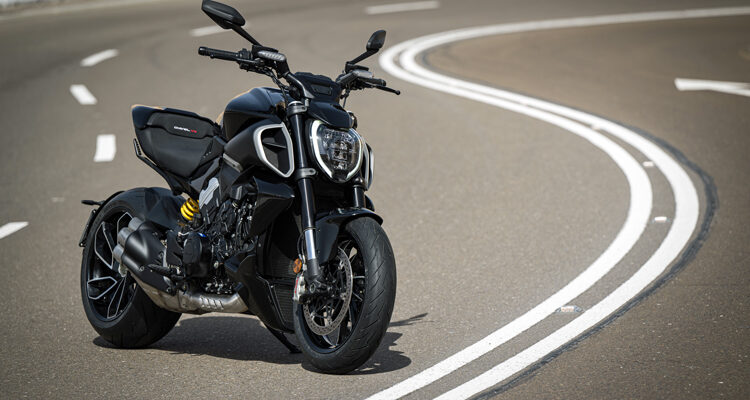Motorcycling loves its categories; if we’re honest about most bikers, that melds with many of our meticulous mindsets. Studying the definitions of each class and learning what makes a machine tick can fill any gearhead’s mental garage. And we, the ever-faithful motorcycle fanbase, blissfully live by those rules. But what happens when a manufacturer lets a designer’s pen slip outside those stone-carved lines? Like a kid with a coloring book, we learn that rules are only made to be broken, and that’s what the 2023 Ducati Diavel V4 is here to prove.
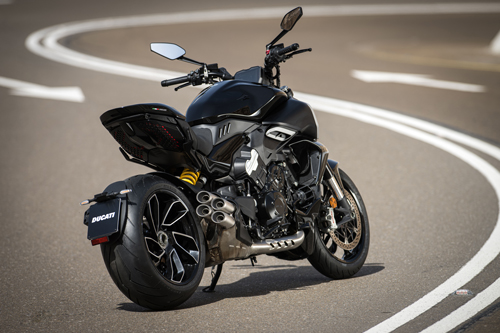
A cruiser is long, low, and American V-twin powered—so it must be; a sportbike is uncompromising, racetrack-focused, and never the twain shall meet—Amen. Since the Diavel’s inception 11 years ago, Ducati has demonstrated that these two worlds do not live in isolation. All it takes is some colorful thinking about how a cruiser should handle, along with the brand’s time-honored tradition of stuffing superbike engines wherever they fit, and you’ve got something that thumbs its nose as Webster himself.
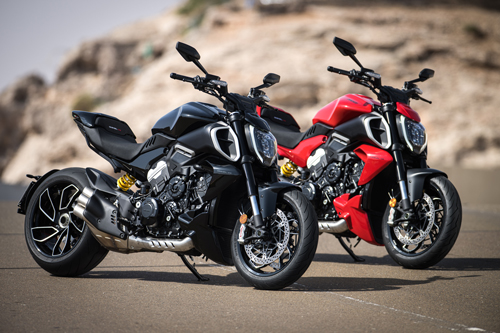
Radically different as the Diavel might be from anything in the Harley-Davidson or Indian Motorcycle stables, the marques share an engine-centric philosophy and play the cruiser fiddle like a charm. No other community oohs and aahs at powerplants quite like those in the V-twin world, as they proudly raise their glasses to torque, torque, and more torque.
Oddly enough, the Italian maker isn’t so different in that specific regard. The original Diavel used a stump-pulling 1198cc twin-cylinder engine way back when, then graduated to the imminently grunty 1260 DVT (Desmodromic Variable Timing). The spotlight now shines on the 1158cc Granturismo V4, repping an intense 168 horsepower and 93 ft-lbs. of torque, borrowed from the Multistrada V4 ADV machines. And all these ponies know more than one trick, too.
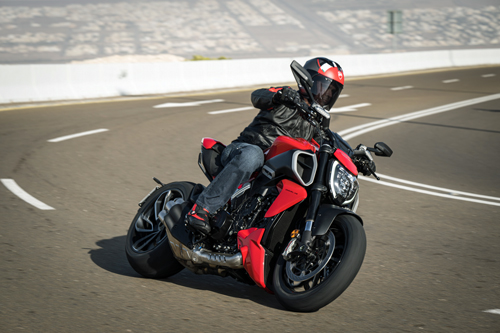
Opting for the desmo-valvetrain-free V4 is a wise choice by the firm since it flexes an industry-leading 60,000-kilometre valve service, bolstered by oil change services every 9000 miles, helping keep service costs much lower on this $30,795 machine much lower than prior iterations. That’s not to say there aren’t a handful of changes to suit its lean and mean role: New camshafts and shortened first gear give the barroom brawler even more wallop off the bottom.
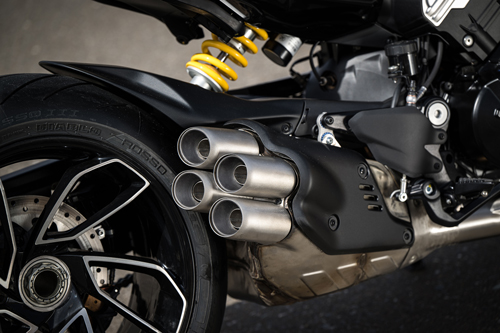
The V4 is smooth in a way that the twins could only dream, pulling with authority and character, leaving all that low-rpm big twin clatter in the past. Naturally, that feeds directly into massive midrange power to help riders assault any canyon road and launch from apex to apex. Unlike your average V-twin twin, this has all the top-end snarl of a sportbike, letting riders get a taste of the Panigale. Twist the grip, and you’re nearly teleported into triple-digit speeds that’d make any 1%er wince. Its bidirectional quickshifter and throttle represent the kind of excellence we’ve come to expect from the brand, making riders reach for the heavy hydraulic clutch only during starts to stops.
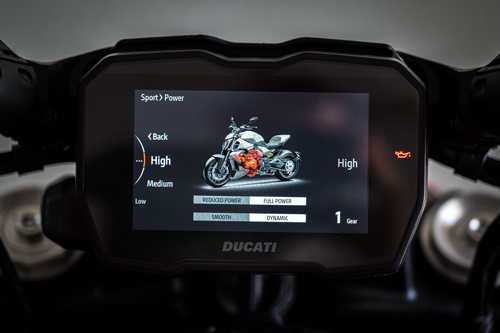
The tech wizardry permeates the affair, and it’s an absolute given for bikes rolling out of the brand’s Borgo-Panigale factory since every model down to the Scrambler utilizes IMU-supported rider aids. We’ve got the full suite of aids trickling down from its top-tier models, delivering adjustable cornering ABS, lean-sensitive traction control, wheelie control, cruise control, launch control, and throttle maps, all ripe for the fiddling via a full-color TFT display.
It aligns with that general theme rear-cylinder bank deactivation that we’ve seen on Ducatis for some time now. The Italians are taking things further with an “extended” rear-cylinder cut when operating below 4000rpm, save for when in first gear. Any quick throttle blip and it seamlessly transitions back to a V4. Unless you listen for the exhaust note change, it’s damn near imperceptible. And here is why we’re dedicating pixels to this feature: It’s necessary since any thoroughbred V4 engine will generate heat, which didn’t go unnoticed while exploring the backroads of Julian, California. Thankfully, Julian Pie Company and its Pie à la Mode was a tasty reprieve.
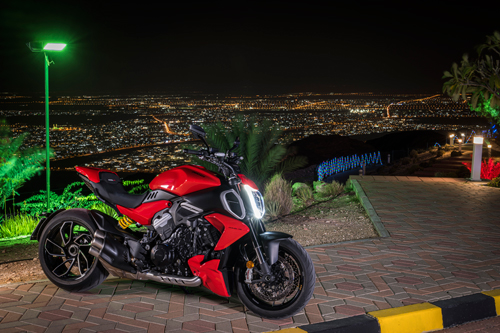
That’s where any common threads can be pulled together if we’re looking towards our American friends and their low-slung steeds. Sure, it’s no secret that Ducati’s designers are inspired by the broad-shouldered, bulldog stance we’ll see from cruisers. However, the Diavel provides a casual riding position akin to your average standard motorcycle. The new V4’s seat is a bit higher, and the handlebars are closer to the rider, keeping you propped up comfortably. Although, the secret sauce to all this is the mid-mount controls that allow riders to distribute weight properly—all things we can’t say of bikes coming out of America’s Midwest.
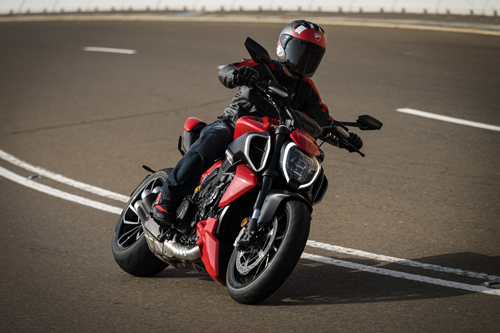
Ducati is known for its sport inclinations and perhaps still the greatest trick that the Diavel has ever pulled. Sure, the long wheelbase, extended rake, and enormous 240-series rear tire wouldn’t indicate as such, yet that’s a trait that we’ve always known the Italian bruiser to maintain. This isn’t without explanation, and what’s improving things is a 29-pound weight loss regiment when stacked against the now-defunct Diavel 1260. We’d also be remiss if we didn’t doff our caps toward the counter-rotating crankshaft within the V4 mill, letting it flip-flop from side to side nicely.
That’s all to say its hefty-for-a-sportbike 520-pound claimed curb weight is borderline meaningless when you gracefully dip the Diavel into curves. With a twisty section of road astern, it begs to hunt down conventionally sporting steeds and show them what its big rear-end can do in the canyons. Its enthusiasm is only tempered by the peg feelers, where you’ll quickly discover that customizing them with the help of your favorite backcountry road is necessary. Though to quell any raised eyebrows, it doesn’t necessarily lack ground clearance; it merely uses all of it and then some.
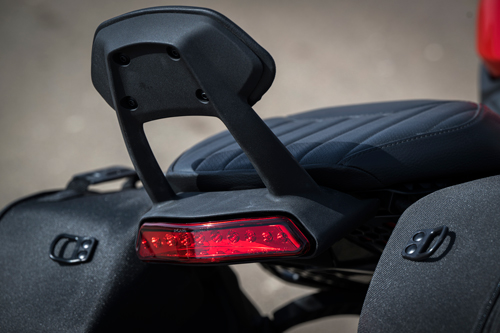
Undoubtedly, a bike of this stature is appointed with high-quality components. The finish is up to par with its price tag, and Brembo Stylema calipers offer the same kind of braking performance available on the brand’s litre bikes, such as the Streetfighter V4 or Panigale V4 motorcycles.
Found at each end of the lighter aluminum monocoque chassis, the Diavel has waved goodbye to its former steel-trellis frame and twin-cylinder engine with this update. Fully adjustable Marzocchi suspension returns to action and provides excellent ride quality, whether plodding along at parade pace or sowing wild oats. As good as the suspenders are, the Diavel is worthy of semi-active Öhlins units commonly seen on Ducati’s up-spec “S” models. In that sense, perhaps the Borgo-Panigale-based team is leaving something for 2024.
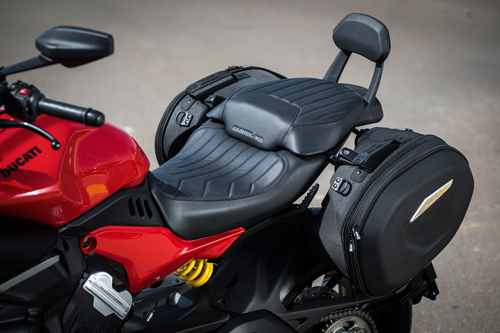
Doing bikes by the numbers isn’t a claim we can fairly lay at Ducati’s feet. But, concerning its Diavel V4, there is something greater taking place. The cruiser rules are steadfast and unwavering, with few manufacturers daring to think beyond category confines meaningfully. We like H-Ds and Indians for what they are, but change comes at a glacial pace. There is no doubt that the Italian maker and its cruiser-inspired platform continue to ignore dogma, adding to the pages of history books in its own unmistakably colourful way.



